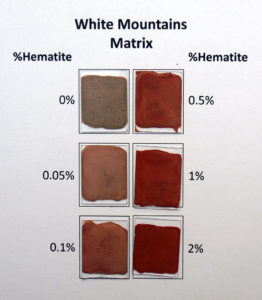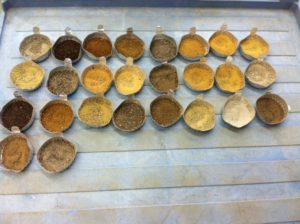As a biogeochemist, when I see red, I think iron, specifically, iron oxides.
Iron oxides, particularly hematite, turns things red. Hematite provides more than just an attractive hue, it is important in soils as an active surface for chemical reactions to occur. Chemical reactions such as oxidizing metals or grabbing metals out of solution. This is quite important for toxic metals.
We as humans are great at seeing the red hematite in soils, however, our basic laboratory techniques for seeing hematite in soils is not as great.
For example, take a look at the color chart below. Our most effective techniques of quantifying (or simply counting) minerals such as optical mineralogy and X-ray diffraction cannot see the differences in red, from 0% to 2%. They cannot see it, but we can see it clearly! It can take about up to 5% hematite by mass for X-ray diffraction to begin to see the red.

After trying my best to use X-ray diffraction to ‘see’ the red, I wondered: If our eyes do a much better job, why don’t we develop a technique mirroring how our eyes function?
Working with Dr. William Balsam while doing my PhD, we attempted to use near-ultraviolet light to visible light spectrum analysis to determine if we can calculate the concentration of hematite in the soil. We were able to create nice graphs showing that different wave lengths of light bouncing off of a sample could be affected by the addition of hematite.

Reflection/absorption of light of different waves lengths from soil.
However, when we applied this technique to actual soil samples, we ran into two problems. Organic matter loves to absorb light and gave false positives for the presence of hematite. Next, iron oxides can exist in many other colors that are not really red, more of orange or yellow. Thus, we cannot apply this technique directly to soil samples without getting rid of organic matter and turning all the iron oxides to hematite using a furnace at high temperatures (>400 degrees Celsius!).

Although this was only semi-successful, it was a cool experiment that was never published.
C’est la vie